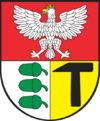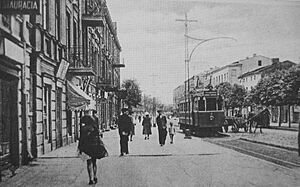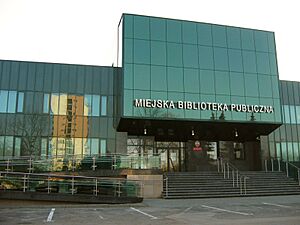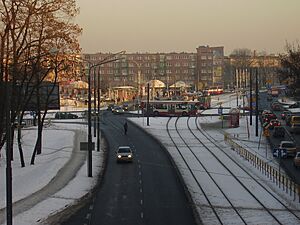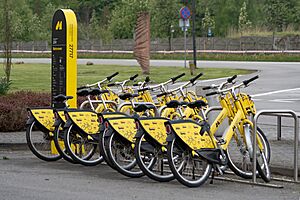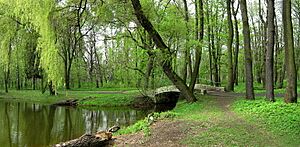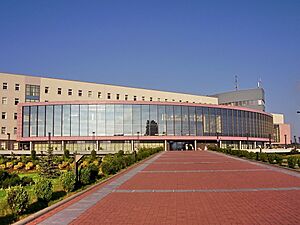Dąbrowa Górnicza facts for kids
Quick facts for kids
Dąbrowa Górnicza
|
|||
|---|---|---|---|
|
|||
|
|||
| Country | |||
| Voivodeship | |||
| County | city county | ||
| City rights | 1916 | ||
| Area | |||
| • City | 188 km2 (73 sq mi) | ||
| Population
(31 December 2021)
|
|||
| • City | 116,971 |
||
| • Density | 622.2/km2 (1,611/sq mi) | ||
| • Urban | 2,746,000 | ||
| • Metro | 4,620,624 | ||
| Time zone | UTC+1 (CET) | ||
| • Summer (DST) | UTC+2 (CEST) | ||
| Postal code |
41–300 to 42–530
|
||
| Area code(s) | +48 32 | ||
| Car plates | SD | ||
| Primary airport | Katowice Airport | ||
| Website | http://www.dabrowa-gornicza.pl/ | ||
Dąbrowa Górnicza is a city in southern Poland, close to Katowice and Sosnowiec. It's located in the eastern part of the Silesian Voivodeship, where the Czarna Przemsza and Biała Przemsza rivers meet. These rivers are branches of the Vistula.
Even though Dąbrowa Górnicza is part of the historic region of Lesser Poland, it is now in the Silesian Voivodeship. The city is also part of the larger Katowice urban area, which has about 2.7 million people. The even bigger Katowice-Ostrava metropolitan area has around 5.2 million people. As of December 2021, Dąbrowa Górnicza itself has a population of 116,971 people.
Contents
- Exploring Dąbrowa Górnicza: Location and Areas
- A Look Back: The History of Dąbrowa Górnicza
- Learning in Dąbrowa Górnicza
- Getting Around: Transport in Dąbrowa Górnicza
- Nature and Fun: Culture and Green Spaces
- Sports in Dąbrowa Górnicza
- Famous People from Dąbrowa Górnicza
- Sister Cities
- Images for kids
- See also
Exploring Dąbrowa Górnicza: Location and Areas
Dąbrowa Górnicza is the largest city in its province by land area, covering 188 square kilometers. This makes it the 9th largest city in Poland in terms of size. The city is built among hills, with its elevation ranging from 258 to 390 meters above sea level. It shares borders with several other areas, including Będzin County, Zawiercie County, Olkusz County, and the city of Sosnowiec. It also borders the towns of Będzin, Siewierz, and Sławków.
The name Dąbrowa comes from the Polish word dąb, which means "oak tree". This suggests that the original village was once covered by oak forests. In 1919, the word Górnicza was added to the name. This word means "mining" and was used to show that the city was an important coal-mining center. It also helped to tell it apart from other towns like Dąbrowa Tarnowska.
What are the City's Districts?
Dąbrowa Górnicza is divided into many smaller areas called districts. Some of these include Antoniów, Błędów, Bugaj, Centrum, Dziewiąty, Gołonóg, Korzeniec, Kuźniczka Nowa, Łazy Błędowskie, Łęka, Łęknice, Łosień, Marianki, Mydlice, Okradzionów, Piekło, Ratanice, Reden, Sikorka, Strzemieszyce Małe, Strzemieszyce Wielkie, Trzebiesławice, Trzydziesty, Tucznawa, Ujejsce, and Ząbkowice. From 1977 to 1984, the town of Sławków was also a district of Dąbrowa Górnicza.
A Look Back: The History of Dąbrowa Górnicza
In the early 1700s, Dąbrowa was a small farming village. It was first mentioned in records on July 25, 1726. By 1787, about 184 people lived there.
Some parts of Dąbrowa, which are now districts, are much older. For example, Trzebieszowice was first mentioned in the 1100s, and Błędów in 1220. Strzemieszyce and Ujejsce were known in the 1300s, and Gołonóg in the 1400s.
After Poland was divided for the third time in 1795, Dąbrowa became part of Prussia. The Prussians found a lot of coal here. The first coal mine was started in 1796. This mine brought many workers, and a settlement grew around it.
In 1807, Dąbrowa became part of the Polish Duchy of Warsaw. Later, in 1815, it was controlled by Russia. More mines opened, like the Cieszkowski Coal Mine in 1846. A zinc factory started in 1823, and the Huta Bankowa steel works, which still operates today, was built in 1834.
The first primary school opened in 1820, and the first Catholic church was built in the 1870s.
In 1909, Dąbrowa Górnicza became a gmina (a type of local government area). Even though it had 30,000 people, it didn't become a town until August 18, 1916. This happened when Austrian authorities, who were in control during World War I, agreed to make it a town. After the war, in 1918, Poland became independent again. Fifteen local Polish boy scouts died fighting for Poland's independence between 1914 and 1920.
Dąbrowa Górnicza During World War II
In September 1939, at the start of World War II, Germany invaded the city. German groups called Einsatzgruppen carried out terrible acts against Polish people. In September 1939, German soldiers also killed 14 Polish boy scouts from nearby villages in what is now the Tucznawa district. Many Poles from Dąbrowa Górnicza were also killed in other places.
Under German occupation, the city was directly added to Germany. At least 14 Polish police officers from Dąbrowa were killed by the Russians in the Katyn massacre in 1940. More Poles were executed by the Germans during the war. Over 40 local Polish boy and girl scouts were killed by the Germans, some in the Auschwitz concentration camp. More than 60 local miners were also killed in Auschwitz.
In October 1941, the Germans forced over 100 Poles to leave their homes. These Poles were sent to work in Germany or in factories. Their homes were given to German settlers. The Germans also ran forced labor camps in the local coal mine. More than 4,000 local Jewish people were forced into a ghetto and later killed in death camps. The German occupation ended in 1945.
Recent Times in Dąbrowa Górnicza
After World War II, in 1945, Dąbrowa Górnicza became part of the Katowice Voivodeship.
In 1968, an important church in the city, Saint Mary of the Angels, was visited by Stefan Wyszyński, the leader of the Catholic Church in Poland, and Karol Wojtyła, who later became Pope John Paul II.
The 1970s saw the building of the Katowice Steelworks. Today, this is Poland's largest steel plant and is owned by ArcelorMittal. The city grew a lot in size and economy during the 1970s. In 1975 and 1977, nearby towns like Strzemieszyce Małe, Strzemieszyce Wielkie, and Ząbkowice became part of Dąbrowa Górnicza. The city's population was highest in 1982, with 152,373 people. In 1984, Marianki and Ratanice also became new districts of the city.
In the 1990s, all the local coal mines closed because there wasn't enough coal left. In 1993, Trzebiesławice also became a new district of Dąbrowa Górnicza.
Learning in Dąbrowa Górnicza
The city has several places for education:
- Silesian Technical University, which offers a Chemistry course.
- WSB University, which used to be called Wyższa Szkoła Biznesu w Dąbrowie Górniczej.
- Wyższa Szkoła Planowania Strategicznego.
Getting Around: Transport in Dąbrowa Górnicza
Dąbrowa Górnicza is a hub for important roads. These include expressway S1 and national road 94. Expressway S1 connects directly to motorway A4 and to Katowice International Airport.
The city also has a good railway system, including the Warsaw-Katowice line. There are nine train stations within the city limits: Dąbrowa Górnicza, Dąbrowa Górnicza Pogoria, Dąbrowa Górnicza Gołonóg, Dąbrowa Górnicza Ząbkowice, Dąbrowa Górnicza Sikorka, Dąbrowa Górnicza Strzemieszyce, Dąbrowa Górnicza Wschodnia, Dąbrowa Górnicza Huta Katowice, and Dąbrowa Górnicza Południowa. Express and fast trains stop at Dąbrowa Górnicza and Dąbrowa Górnicza Ząbkowice.
There is also a tram network, which is part of the Silesian Interurbans. This tram system is one of the oldest and largest in Europe, running since 1894 and covering over 200 kilometers of tracks.
A public bicycle system called MetroBike is also available. It has 924 stations and over 7,000 bicycles in Dąbrowa Górnicza and nearby cities.
Nature and Fun: Culture and Green Spaces
Dąbrowa Górnicza has many green areas. There are over 800 hectares of lakes, including the beautiful Pogoria (lakes) complex. The city also has 180 hectares of parks and 4100 hectares of forests. Part of the Eagles' Nests Landscape Park is also near the city.
The largest desert in Poland and Central Europe, the Błędów Desert, is located within the city limits.
For culture, Dąbrowa Górnicza has the Palace of Zagłębie Culture, the City Museum Sztygarka, and various music and arts schools.
Sports in Dąbrowa Górnicza
The city's most famous sports team is the basketball team MKS Dąbrowa Górnicza. They play in the top Polish basketball league. The local football clubs are Zagłębie Dąbrowa Górnicza and Unia Ząbkowice, which play in lower leagues.
Famous People from Dąbrowa Górnicza
- Karol Adamiecki (1866–1933), an economist and engineer.
- Aleksander Zawadzki (1899–1964), who was the head of state of Poland from 1952 to 1964.
- Jerzy Pławczyk (1911–1989), an athlete who competed in the 1932 and 1936 Summer Olympics.
- Sobiesław Zasada (born 1930), a famous rally driver and businessman.
- Janusz Gajos (born 1939), a well-known actor.
- Dawid Podsiadło (born 1993), a popular singer.
- Maja Chwalińska (born 2001), a tennis player.
Sister Cities
Dąbrowa Górnicza has friendly relationships with other cities around the world. These are called twin towns:
 Alchevsk, Ukraine
Alchevsk, Ukraine Câmpulung Moldovenesc, Romania
Câmpulung Moldovenesc, Romania Mediaș, Romania
Mediaș, Romania Studénka, Czech Republic
Studénka, Czech Republic
Images for kids
See also
 In Spanish: Dąbrowa Górnicza para niños
In Spanish: Dąbrowa Górnicza para niños






